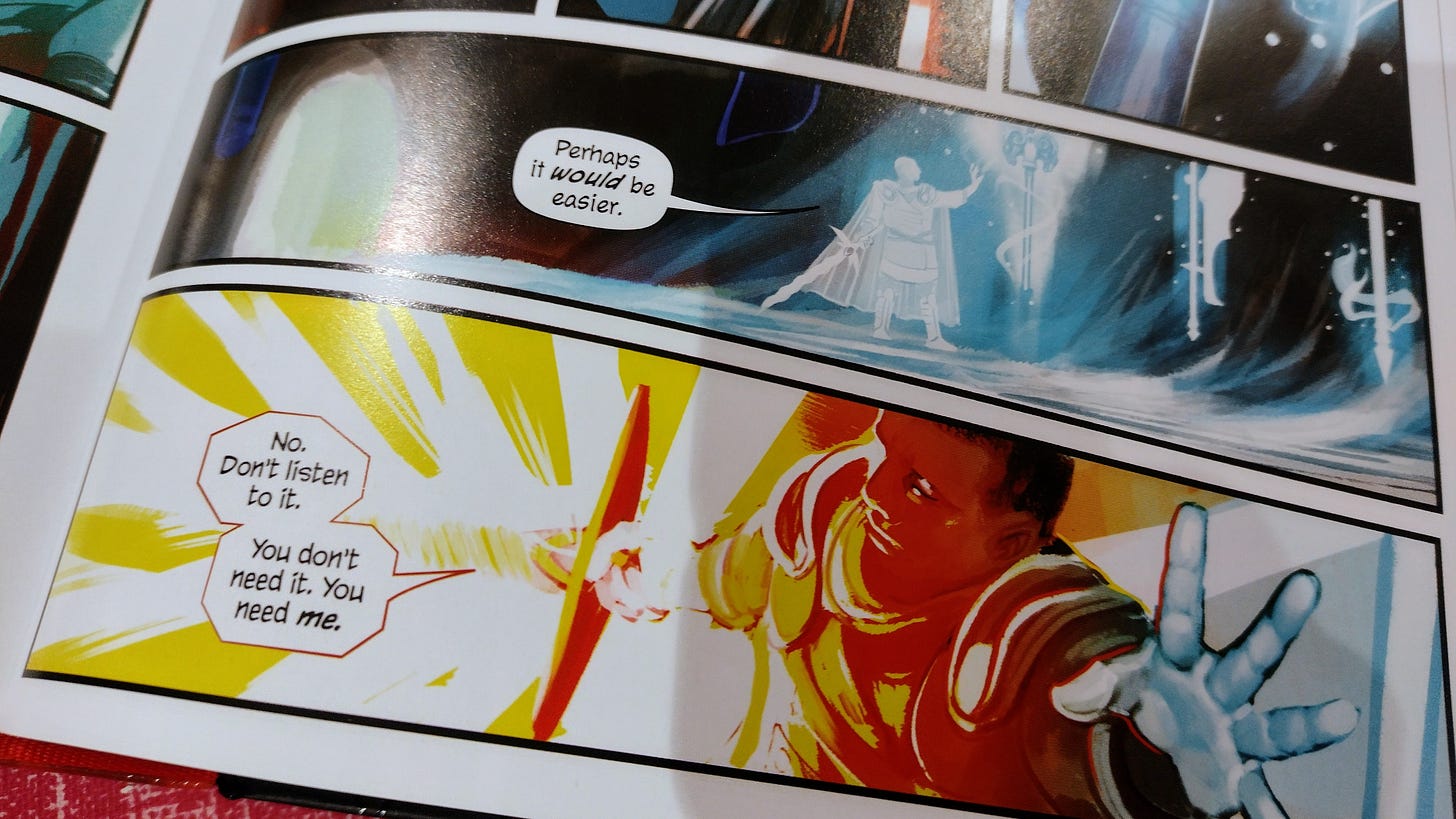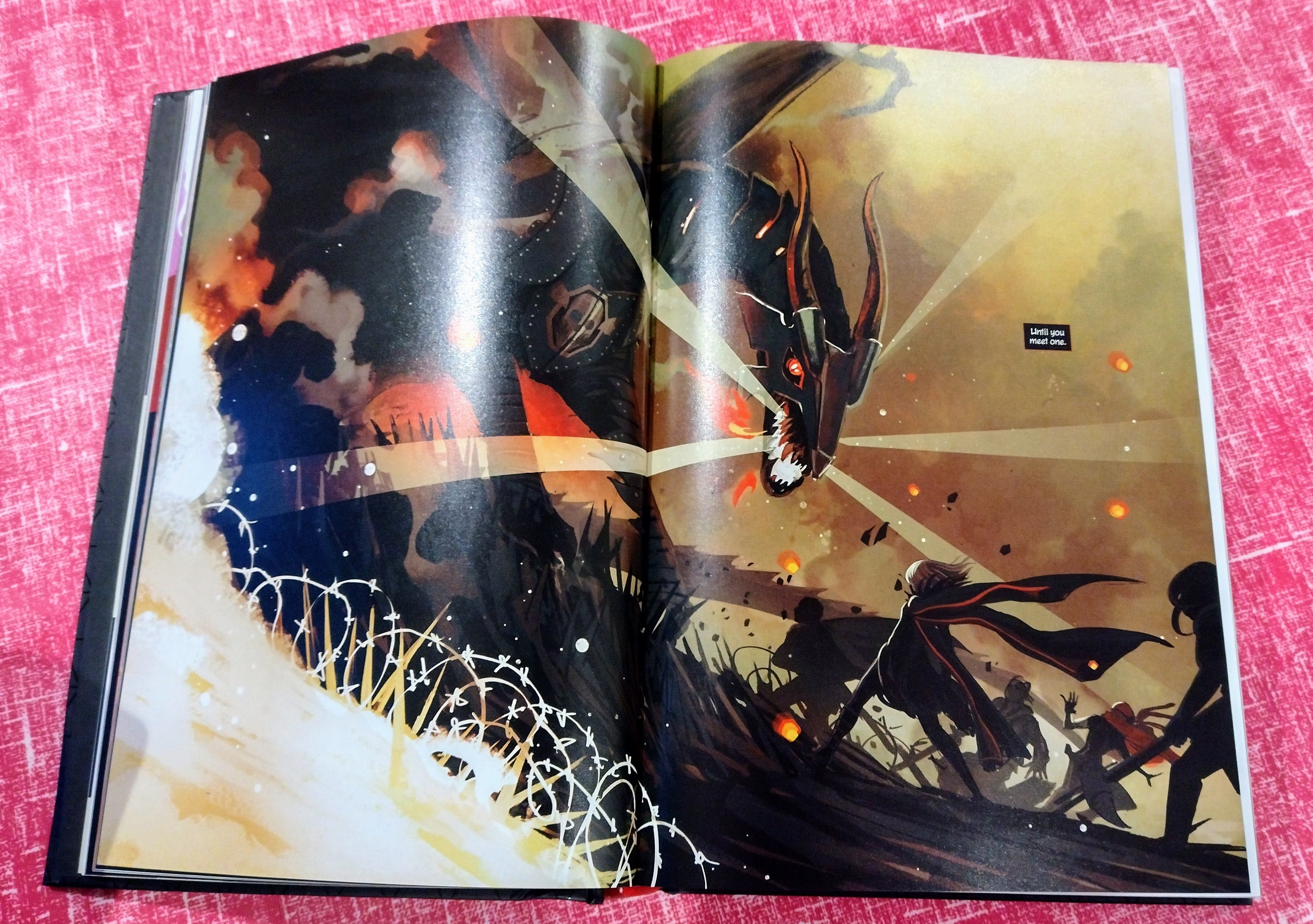The slow (and then sudden) demise of Twitter made me realise that I rather missed having a place to natter about random interesting stuff and recommend things wot I have liked.
And so we have:
If you’re only here to read new chapters of Tales from the Triverse, that’s fine. If you only want writing tips, also OK. Customising which bits of the newsletter you want to receive is fortunately very easy. Just click here.
Right.
DIE
I’ve just finished reading DIE, the epic fantasy deconstruction from Kieron Gillen and Stephanie Hans. I had read the first three trades, but I’ve never been good at keeping up with comic release schedules. And then Amazon nuked Comixology. Fortunately this thing has now been released upon the world:
Gaze upon it. The entire story, top to bottom, in one single, massively chonky volume.
Immediate thing to note: Clayton Cowles is on the front cover as well. As he should be, of course: he’s the letterer, a key creative role on any comic, that for most of my life I have largely overlooked. Which is embarrassing. And if any letterer demonstrates their vital contribution to the craft, it’s Clayton Cowles. Using fonts and elegant design he enhances dialogue delivery and deepens the characters: his work is the connecting tissue between the writing and the art.
Quick note: I’m avoiding big spoilers, because I want you to get this and read it and enjoy it as much as I did. But I will be showing and discussing a few panels from the story, so if you want to go in completely cold stop here, go buy it, read it, and come back in a bit.
Here’s a little example - note the difference in the speech bubbles between the two panels:
Most characters have distinct bubble design. You often don’t even notice it consciously, but it subtly adds an extra tone to the text. It’s like when dialogue in a film goes from words in the script to sounds coming from an actor. It’s comics dialogue as performance.
I’ve not actually mentioned what DIE is about, have I? well, it’s about all sorts of Big Things, but the story setup is ostensibly a tweak to the 1980s Dungeons & Dragons cartoon. What if kids got trapped in a fantasy land? And, crucially, what happens to them when they’ve grown into middle-aged adults?
The book examines fantasy literature, roleplaying, games in general, escapism, and pulls each of them apart. That DIE manages to be a rollicking fantasy adventure in its own right, while simultaneously performing an autopsy on the genre, is quite a magic trick.
It’s all rooted in character, with an ensemble cast - or party - of variously broken grown-ups, unable to contend with their various obsessions and the fantasies of their youth. DIE is a celebration of all these things and a criticism, one which I’ll need to re-read to truly unpick.
Kieron Gillen’s work has always been fixated upon form and rules. His fiction often hinges around the structures and scaffolds that hold up artifice. Whether that’s pop music in Phonogram, war in Uber, belief and fandom in Wicked + Divine or the world building and magic system of DIE.
Even his work for Marvel is as Gillen as possible - last summer he was put in charge of their massive cross-over event, spinning out of the Eternals comic he was writing and sucking in Avengers, X-Men and everything else. I initially was quite grumpy about it, as I don’t generally like the big corporate cross-overs which expect you to go and buy a ton of extra comics. I was reading Eternals because I like Kieron’s work, not because I wanted to read about the Eternals. That was before the cross-over story actually unfolded and I realised it was somehow Peak Gillen. It was about superhero power structures, and godhood, and played with Marvel narrative structures in absolutely delightful ways. I’m not sure how he convinced Marvel to let him do it, but I’m very glad they did.
DIE is set in a world on the planes of a D20 dice. Each side is its own realm, with its own rules. It all slots together in a formal manner, although the story only reveals the details slowly. Each part of the book visits a different region, with its own idiosyncrasies and literary and gaming influences. It’s very clever, very dense, and demands you pay attention (much like that Marvel cross-over event I mentioned). DIE is not a fun romp: it takes effort, and will leave you exhausted. In a good way.
There’s a pretentious air to a lot of Kieron’s stuff, and I suspect he’d be the first to admit that. The crucial thing is that it’s always mixed in with a delightful playfulness, rather than pomposity. The deconstructionism is there because he loves this stuff and wants to explore and understand it. He’s a forensic investigator of pop culture. I mean, he’s made an actual RPG based on the comic.
In my previous life producing the Writing Life podcast I got to talk to Kieron about his world building. Well worth a listen:
Something that occasionally frustrates me about comics is when the artist changes during the book. This can work in its favour on occasion (in fact, see Wicked + Divine), but more often than not it ends up feeling like the cinematographer has changed halfway through a movie. DIE is the work of a single artist, Stephanie Hans, who has a particularly painterly style.
I mean, look at this thing:
The entire book is like that. The use of light and dark and limited colour palettes is quite the thing. Look at the foreground barbed wire. Look at it.
Stephanie’s work is the perfect match for this particular story. It’s Lord of the Rings concept art come to life in a massive graphic novel, or artwork from collectible cards applied on a massive scale. Pretty much any individual panel or page is worthy of being framed and stuck up on the wall.
If you’ve played video or tabletop role playing games it’s a must-read. It helps if you have a general notion of the history of fantasy literature. But even if you have none of that and are coming in cold, DIE works as a standalone story. A story about stories, if you will.
Getting hold of the DIE hardback is likely to be increasingly tricky, but you can pick up the entire story in the individual trade paperbacks. Grab the whole thing and dive in - it’s a story that will linger in your head for a long time.









This looks absolutely insane! Love the concept of different rules on each surface of the D20 die. I’ll have to get this book. Thanks for sharing.